2013 Peugeot 508 Hybrid display
[x] Cancel search: displayPage 105 of 340
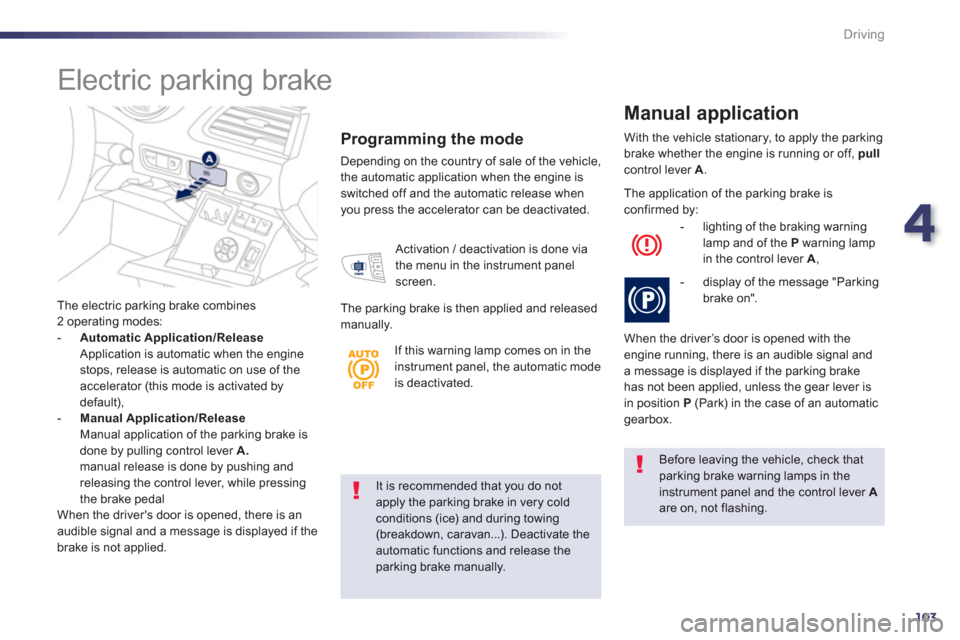
4
103
Driving
It is recommended that you do not apply the parking brake in very cold conditions (ice) and during towing
(breakdown, caravan...). Deactivate theautomatic functions and release theparking brake manually.
Before leaving the vehicle, check that parking brake warning lamps in the instrument panel and the control lever Aare on, not flashing.
The electric parking brake combines
2 operating modes:
-
Automatic Application/Release Application is automatic when the engine stops, release is automatic on use of the accelerator (this mode is activated by
default), -Manual Application/Release Manual application of the parking brake is done by pulling control lever A. manual release is done by pushing and releasing the control lever, while pressing
the brake pedal
When the driver's door is opened, there is an
audible si
gnal and a message is displayed if the
brake is not applied.
Programming the mode
Depending on the country of sale of the vehicle,
the automatic application when the engine is switched off and the automatic release whenyou press the accelerator can be deactivated. With the vehicle stationary, to apply the parking
brake whether the en
gine is running or off, pull
control lever A
.
Manual application
Activation / deactivation is done via
the menu in the instrument panel
screen.
The parkin
g brake is then applied and released
manually. The application o
f the parking brake isconfirmed by:
- li
ghting of the braking warning lamp and of the Pwarning lamp
in the control lever A,
- displa
y of the message "Parking brake on".
When the driver’s door is opened with the
engine running, there is an audible signal and
a message is displayed if the parking brake
has not been applied, unless the gear lever is in position P(Park) in the case of an automatic gearbox.
Electric parking brake
If this warning lamp comes on in the instrument panel, the automatic modeis deactivated.
Page 107 of 340
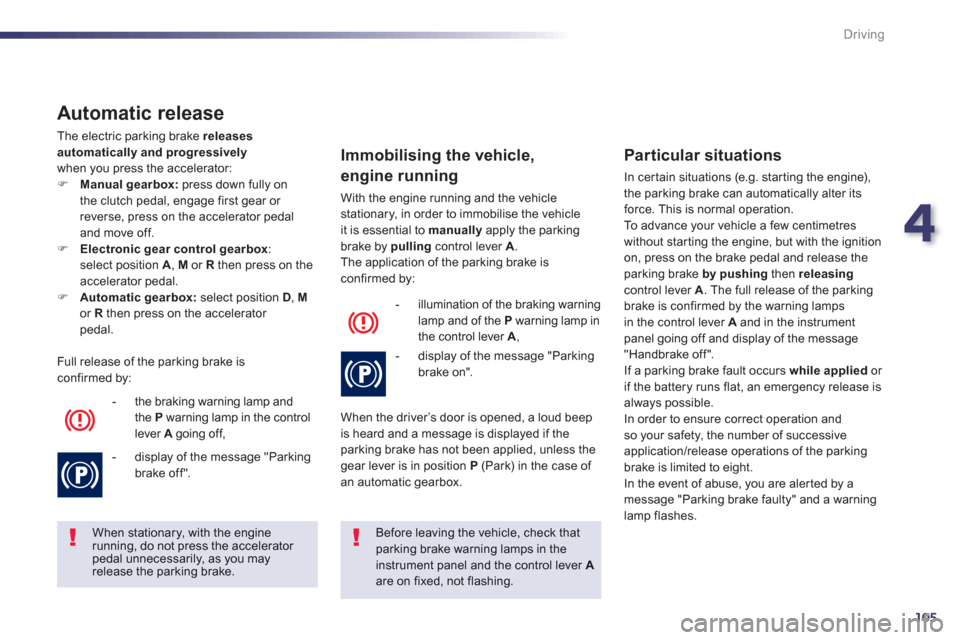
4
105
Driving
Automatic release
The electric parking brake releases automatically and progressively
when you press the accelerator:FManual gearbox:
press down fully on
the clutch pedal, engage first gear or reverse, press on the accelerator pedaland move off.FElectronic gear control gearbox : select position A
, M
or Rthen press on theaccelerator pedal. F Automatic gearbox:select position D , Mor Rthen press on the accelerator pedal.
Full release o
f the parking brake is confirmed by:
- the braking warning lamp and
th
e P warning lamp in the control
lever Agoing off, A
- display of the message "Parking brake off".
When stationary, with the engine running, do not press the accelerator pedal unnecessarily, as you may release the parking brake.
Before leaving the vehicle, check thatparking brake warning lamps in theinstrument panel and the control lever Aare on fixed, not flashing.
Immobilising the vehicle,
engine running
With the engine running and the vehicle
stationary, in order to immobilise the vehicle it is essential to manually
apply the parking
brake by pulling
control lever A.
The application of the parking brake is confirmed by:
- illumination o
f the braking warning
lamp and of the Pwarning lamp in
the control lever A ,
- displa
y of the message "Parkingbrake on".
When the driver’s door is opened, a loud beep
is heard and a message is displayed if theparking brake has not been applied, unless thegear lever is in position P (Park) in the case of an automatic gearbox.
Particular situations
In cer tain situations (e.g. star ting the engine),
the parking brake can automatically alter itsforce. This is normal operation.
To advance your vehicle a few centimetres
without star ting the engine, but with the ignition on, press on the brake pedal and release the
parking brake by pushing then releasingcontrol lever A
. The full release of the parking
brake is confirmed by the warning lamps in the control lever Aand in the instrument
panel going off and display of the message
"Handbrake off".
If a parking brake fault occurs while appliedor
if the battery runs flat, an emergency release is
always possible.
In order to ensure correct operation and
so your safety, the number of successive
application/release operations of the parking brake is limited to eight.
In the event of abuse, you are aler ted by a
message "Parking brake faulty" and a warning
lamp flashes.
Page 108 of 340
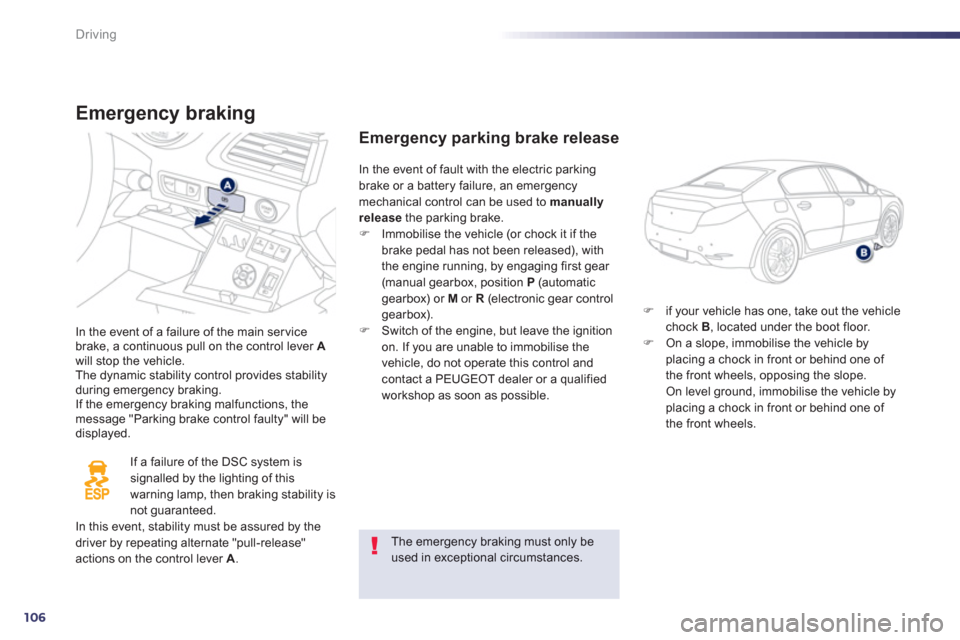
106
Driving
Emergency braking
In the event of a failure of the main servicebrake, a continuous pull on the control lever Awill stop the vehicle.The dynamic stability control provides stability during emergency braking.
If the emergency braking malfunctions, themessage "Parking brake control faulty" will be displayed.
If a failure of the DSC s
ystem is
signalled by the lighting of this
warning lamp, then braking stability is
not guaranteed.In this event, stability must be assured by thedriver by repeating alternate "pull-release" actions on the control lever A.
Emergency parking brake release
Fif your vehicle has one, take out the vehicle chock B , located under the boot floor. FOn a slope, immobilise the vehicle byplacing a chock in front or behind one of
the front wheels, opposing the slope. On level ground, immobilise the vehicle byplacing a chock in front or behind one of
the front wheels.
In the event o
f fault with the electric parkingbrake or a battery failure, an emergencymechanical control can be used to manually
releasethe parking brake.F Immobilise the vehicle (or chock it if the
brake pedal has not been released), with
the engine running, by engaging first gear (manual gearbox, position P(automatic gearbox) or M or R(electronic gear control
gearbox). F Switch of the engine, but leave the ignition on. If you are unable to immobilise the
vehicle, do not operate this control and
contact a PEUGEOT dealer or a qualified
workshop as soon as possible.
The emergency braking must only be used in exceptional circumstances.
Page 111 of 340
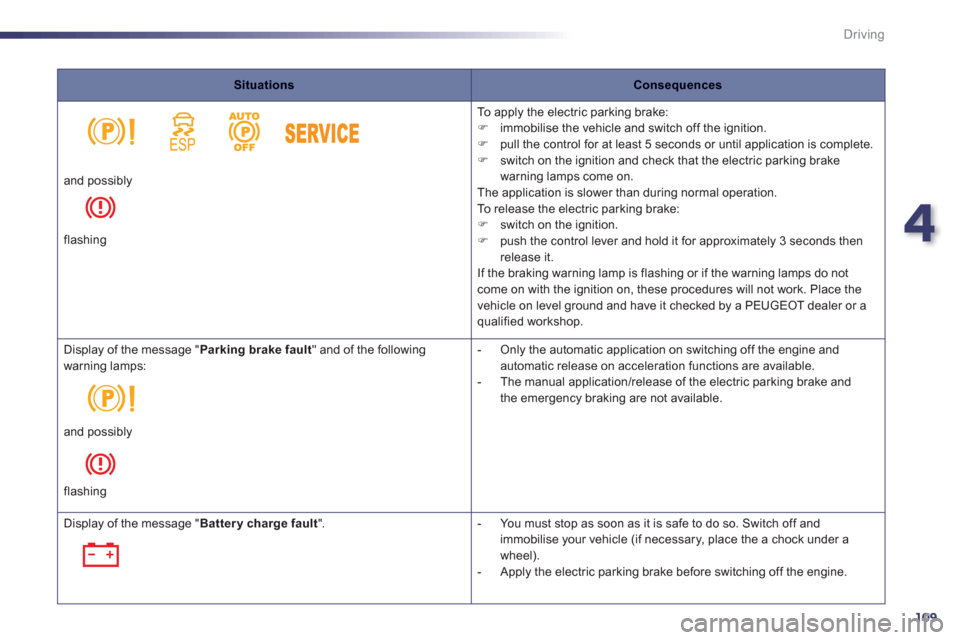
4
109
Driving
SituationsConsequences
To apply the electric parking brake: F immobilise the vehicle and switch off the ignition. F
pull the control for at least 5 seconds or until application is complete.F
switch on the ignition and check that the electric parking brake
warning lamps come on.
The application is slower than during normal operation.
To release the electric parking brake:
F
switch on the ignition. F
push the control lever and hold it for approximately 3 seconds then
release it.
If the braking warning lamp is flashing or if the warning lamps do not come on with the ignition on, these procedures will not work. Place the
vehicle on level ground and have it checked by a PEUGEOT dealer or aqualified workshop. and possibl
y
flashing
Display of the message "Parking brake fault" and of the following warning lamps:
- Only the automatic application on switching off the engine andautomatic release on acceleration functions are available.
- The manual application/release of the electric parking brake and
the emergency braking are not available.
and possibly
flashin
g
Display of the message "Battery charge fault".
- You must stop as soon as it is safe to do so. Switch off and
immobilise
your vehicle (if necessary, place the a chock under a
wheel).
- Apply the electric parking brake before switching off the engine.
Page 116 of 340
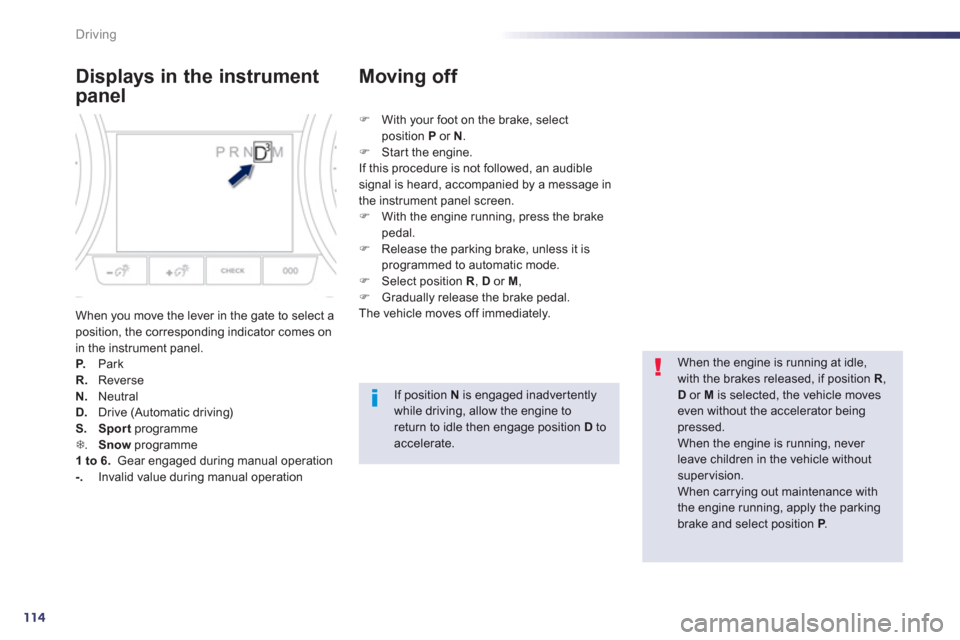
114
Driving
Displays in the instrument
panel
When you move the lever in the gate to select aposition, the corresponding indicator comes on in the instrument panel. P. Park R.ReverseN.
Neutral D.
Drive (Automatic driving)
S. Sport programmeT. Snow
programme 1 to 6.
Gear engaged during manual operation -.Invalid value during manual operation
F
With your foot on the brake, select position Por N.F
Star t the engine.
If this procedure is not followed, an audible
si
gnal is heard, accompanied by a message in
the instrument panel screen.
F With the engine running, press the brake
pedal.F Release the parking brake, unless it is
programmed to automatic mode. F Select position R
, D
or M
, F
Gradually release the brake pedal.
The vehicle moves off immediately.
Moving off
When the engine is running at idle, with the brakes released, if position R,D
or Mis selected, the vehicle moves even without the accelerator being pressed.
When the engine is running, never leave children in the vehicle without supervision. When carrying out maintenance with the engine running, apply the parkingbrake and select position P.P
If position Nis engaged inadvertently while driving, allow the engine to return to idle then engage position Dto accelerate.
Page 118 of 340
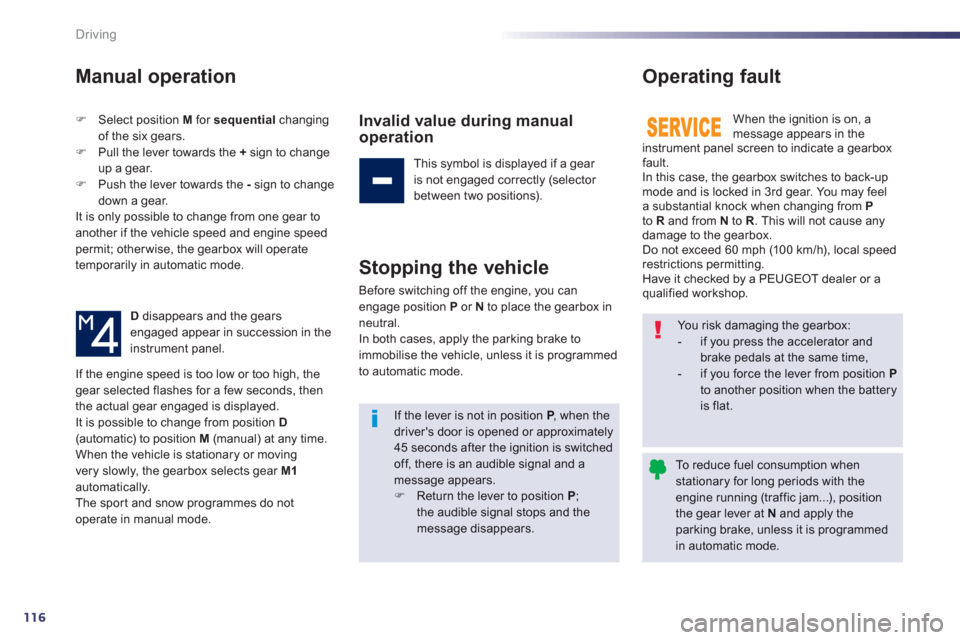
116
Driving
Manual operation
FSelect position M for sequentialchanging
of the six gears.FPull the lever towards the + sign to change
up a gear. FPush the lever towards the -
sign to change
down a gear.
It is only possible to change from one gear to another if the vehicle speed and engine speedpermit; otherwise, the gearbox will operate
temporarily in automatic mode.
D disappears and the gears engaged appear in succession in the
instrument panel.
Invalid value during manual operation
This symbol is displayed if a gear
is not engaged correctly (selector
between two positions).
Stopping the vehicle
Before switching off the engine, you can engage position P
or Nto place the gearbox in
neutral.
In both cases, apply the parking brake to
immobilise the vehicle, unless it is programmed
to automatic mode.
Operating fault
When the ignition is on, amessage appears in the
instrument panel screen to indicate a gearboxfault.
In this case, the gearbox switches to back-up mode and is locked in 3rd gear. You may feel
a substantial knock when changing from Pto Rand from N to R
. This will not cause any
damage to the gearbox.
Do not exceed 60 mph (10 0 km/h), local speed
restrictions permitting.
Have it checked by a PEUGEOT dealer or a qualified workshop.
If the en
gine speed is too low or too high, the gear selected flashes for a few seconds, then
the actual gear engaged is displayed.
It is possible to change from position D(automatic) to position M (manual) at any time.When the vehicle is stationary or movingvery slowly, the gearbox selects gear M1automatically.
The spor t and snow programmes do not
operate in manual mode.
You risk damaging the gearbox:
- if you press the accelerator and brake pedals at the same time,
- if you force the lever from position Pto another position when the batteryis flat.If the lever is not in position P
, when the Pdriver's door is opened or approximately 45 seconds after the ignition is switchedoff, there is an audible signal and a message appears. FReturn the lever to position P;the audible signal stops and themessage disappears.
To reduce fuel consumption when stationary for long periods with the engine running (traffic jam...), positionthe gear lever at Nand apply theparking brake, unless it is programmed in automatic mode.
Page 120 of 340
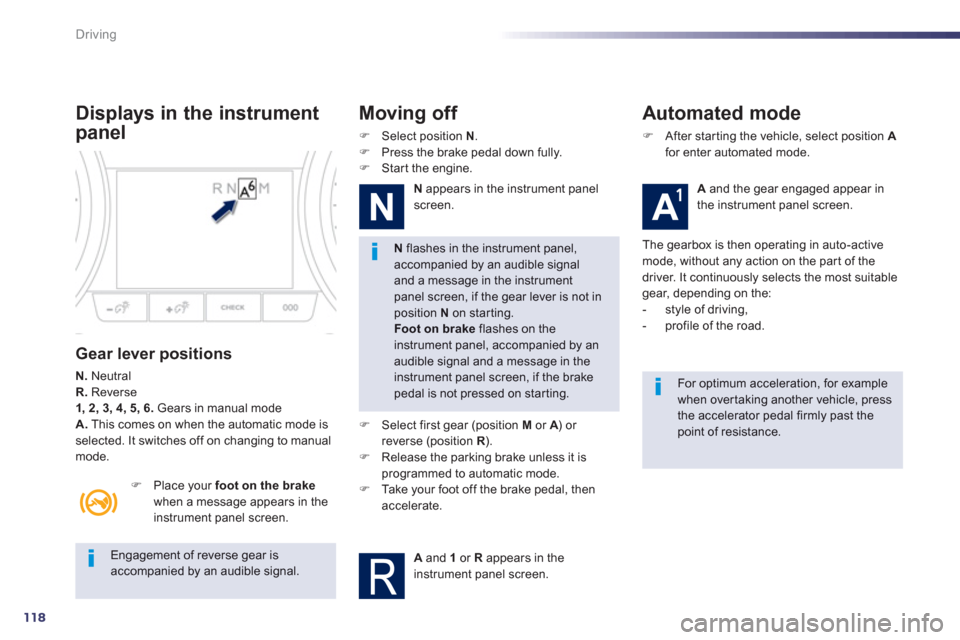
118
Driving
Engagement of reverse gear is accompanied by an audible signal.
N
flashes in the instrument panel, accompanied by an audible signal and a message in the instrument panel screen, if the gear lever is not inposition N
on starting.Foot on brake
flashes on theinstrument panel, accompanied by anaudible signal and a message in theinstrument panel screen, if the brakepedal is not pressed on starting.
For optimum acceleration, for example when overtaking another vehicle, press the accelerator pedal firmly past the point of resistance.
Displays in the instrument
panel
Gear lever positions
N.
Neutral R.Reverse1, 2, 3, 4, 5, 6.Gears in manual modeA.
This comes on when the automatic mode is selected. It switches off on changing to manualmode.
FPlace your foot on the brakewhen a message appears in the
instrument panel screen.
Moving off
F
Select position N . F
Press the brake pedal down fully.
F
Star t the engine.
Nappears in the instrument panel screen.
F
Select first gear (position Mor A
) or A
reverse (position R).RF
Release the parking brake unless it is
programmed to automatic mode. F Ta k e y o u r foot off the brake pedal, thenaccelerate.
Aand 1
or Rappears in the
instrument panel screen.
Automated mode
F
After star ting the vehicle, select position Afor enter automated mode.
A
and the gear engaged appear in
the instrument panel screen.
The
gearbox is then operating in auto-active mode, without any action on the par t of thedriver. It continuously selects the most suitable gear, depending on the:
- style of driving,
- profile of the road.
Page 121 of 340
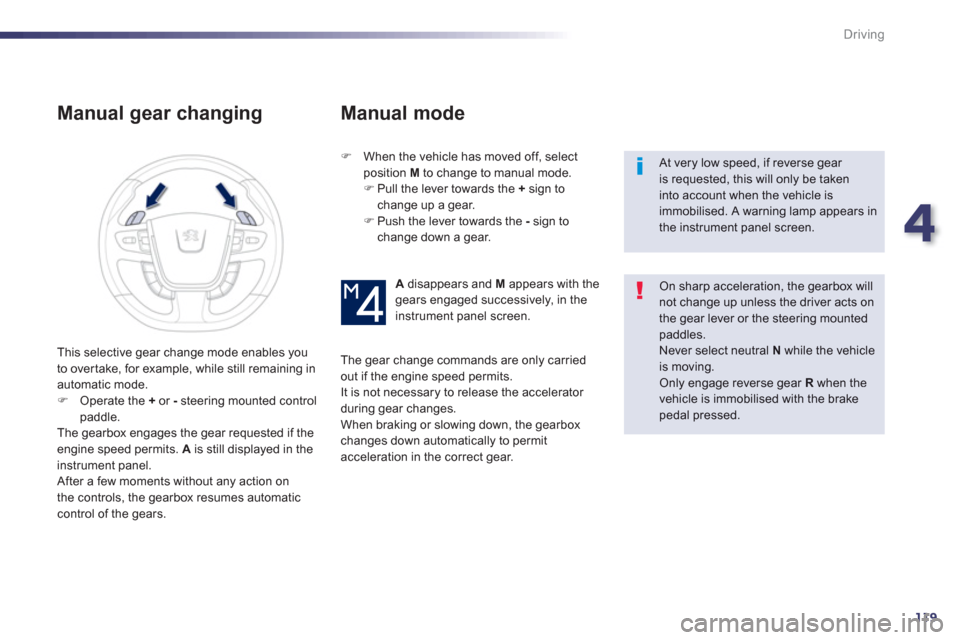
4
119
Driving
Manual gear changing
FWhen the vehicle has moved off, select
position M to change to manual mode. F
Pull the lever towards the +sign to change up a gear. F
Push the lever towards the -sign to change down a gear.
At very low speed, if reverse gear is requested, this will only be takeninto account when the vehicle isimmobilised. A warning lamp appears in the instrument panel screen.
On sharp acceleration, the gearbox willnot change up unless the driver acts onthe gear lever or the steering mountedpaddles. Never select neutral N
while the vehicleis moving. Only engage reverse gear Rwhen thevehicle is immobilised with the brake pedal pressed.
Adisappears and M
appears with thegears engaged successively, in the instrument panel screen.
The
gear change commands are only carried
out if the engine speed permits.It is not necessary to release the accelerator during gear changes. When braking or slowing down, the gearbox
changes down automatically to permitacceleration in the correct gear. This selective
gear change mode enables you
to over take, for example, while still remaining in automatic mode.F Operate the +
or -
steering mounted controlpaddle.
The gearbox engages the gear requested if the engine speed permits. A
is still displayed in theinstrument panel.
After a few moments without any action on
the controls, the gearbox resumes automaticcontrol of the gears.
Manual mode